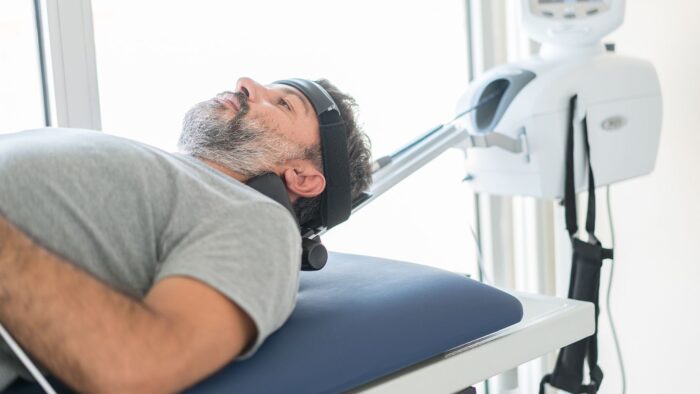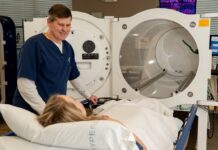
Are you concerned about the state of your neck, back, and shoulders? If you find your spine has been whacked out of alignment through years of misuse, constant repetitive motions, or a sports accident, then visiting the chiropractor may seem like the best solution.
However, there have been horror stories about people who are unlicensed chiropractors or inexperienced professionals who do not adjust the spine correctly – and lead to other life-threatening conditions in patients.
Avoid any issues with your spine in the future by choosing a safe, reliable, and effective alternative – cervical traction. Instead of using chiropractor visits to fix your neck and spine issues, use the traction to replace this potentially dangerous method!
Let’s see the benefits of using the traction, how it works, and why it will be the best choice for YOU! Click here to purchase this device for your needs.
Here are a few reasons why you should use cervical traction to replace chiropractor visits for your neck pain!
What is a chiropractor?

What is a chiropractor and why should you use them? Before you can see why using the traction is superior to using a chiropractor to help with neck and back pain, we need to know what chiropractors can do for you. Since neck and back pain are some of the most common types of chronic ailments, aches, and pains that plague people around the world, patients are always asking for alternative treatment methods to help them lead a pain-free life.
One of the most common doctors who can help neck and back pain are chiropractors – chiropractors are known for helping treat chronic illnesses, injuries, accidents, and trauma to the back. Chiropractic care is specifically the part of treatment that is used to help with the fascia, muscles, joints, and skeletal system that comprises the posterior chain. People with back and neck issues need help with their connective tissue, joints, and tendons to avoid any long-term injuries and illness from causing severe pain.
But how does a chiropractor help treat back pain? If you are considering going to this professional to help with your chronic back aches, knowing the steps beforehand is important to feel confident and secure in your treatment plan. Typically, the chiropractor will examine you and see where the pain is originating – then, the chiropractor will perform manual adjustments to realign the spine and improve your range of motion.

Although chiropractic care has been proven to be effective in terms of neck pain, back pain, and migraines, there are some risks associated with this type of treatment plan. Unlike other holistic therapies and medical treatments that are virtually risk-free, using chiropractic care can be very damaging if you go to someone who is inexperienced or not well-versed in the industry.
Some customers would not be well-suited to go to a chiropractor for adjustments and realigning of their backbone. Those who are on blood thinners or who have osteoporosis might become severely injured if they go to a spinal chiropractor doctor. In this case, you might find that the quick manipulations of the spine can cause more harm than good.
So what are your other alternatives besides going to a chiropractor for back pain and neck pain? If you feel like you are running out of options to treat your chronic pain, then consider trying this new treatment – cervical traction. If you are suffering from spinal pressure, a limited range motion, and daily pain, then using this device is one of the best ways that you can lead a pain-free life!
Why should I choose cervical traction instead?

First things is first – what is cervical traction? Cervical traction, also known as neck traction, is a type of therapy and rehabilitative method that is used to help fix an issue with the neck, spinal integrity, or muscles surrounding the neck and spine. The concept of using this method is that stretching the spine by using weight will help it realign itself and fall back in place.
Although the method can refer to different things in the physical therapy and medical field, the main point of using “traction” with this therapy method is to use a hard pulling force. The pulling force will be exerted on the top of the head to pull the spine apart from itself – helping treat any long-term deformities or pain associated with misalignment of the backbone, dislocation, spinal fractures, or structural issues due to a chronic illness.
Traction will be used in cervical traction to help pull away the spine from itself – by pulling in opposite directions, this uses the force of the pulling mechanism and the force of your body as two opposing forces. The two opposing forces help align the bones, leading to alignment of the spine, and avoiding any sudden movements that can cause further damage to it. Unlike chiropractor visits, use this therapy to replace harsh and uncontrolled movements.
Types of cervical traction

There are three types of traction that you can use to replace chiropractor visits: the most common types are manual and mechanical cervical traction.
- Manual cervical traction is a type of therapy that is used by the doctor using their hands to pull your head – the force of pulling your head away from your spine will help to figure out the origin of your neck pain, stretch neck muscles, get rid of any compression pain, and stretch the spine.
- Mechanical one is the next most popular type that can be used to replace chiropractic visits. Mechanical type is used with a harness that will help stretch your head away from your spine, helping align it, and stretch muscles surrounding your spine and neck.
Conclusion
Are you tired of going to your chiropractor? Use this method to replace the potentially harmful chiropractor visits and use a safe and effective method to safely stretch and align your spine! Even though going to a chiropractor can be helpful in certain circumstances, you may find that you are a patient who would not benefit from this type of forceful manipulation of the spine and connective tissues. For safer and lower-risk alternatives, use the traction to get rid of a limited range motion, muscle pain, and spinal misalignment.








